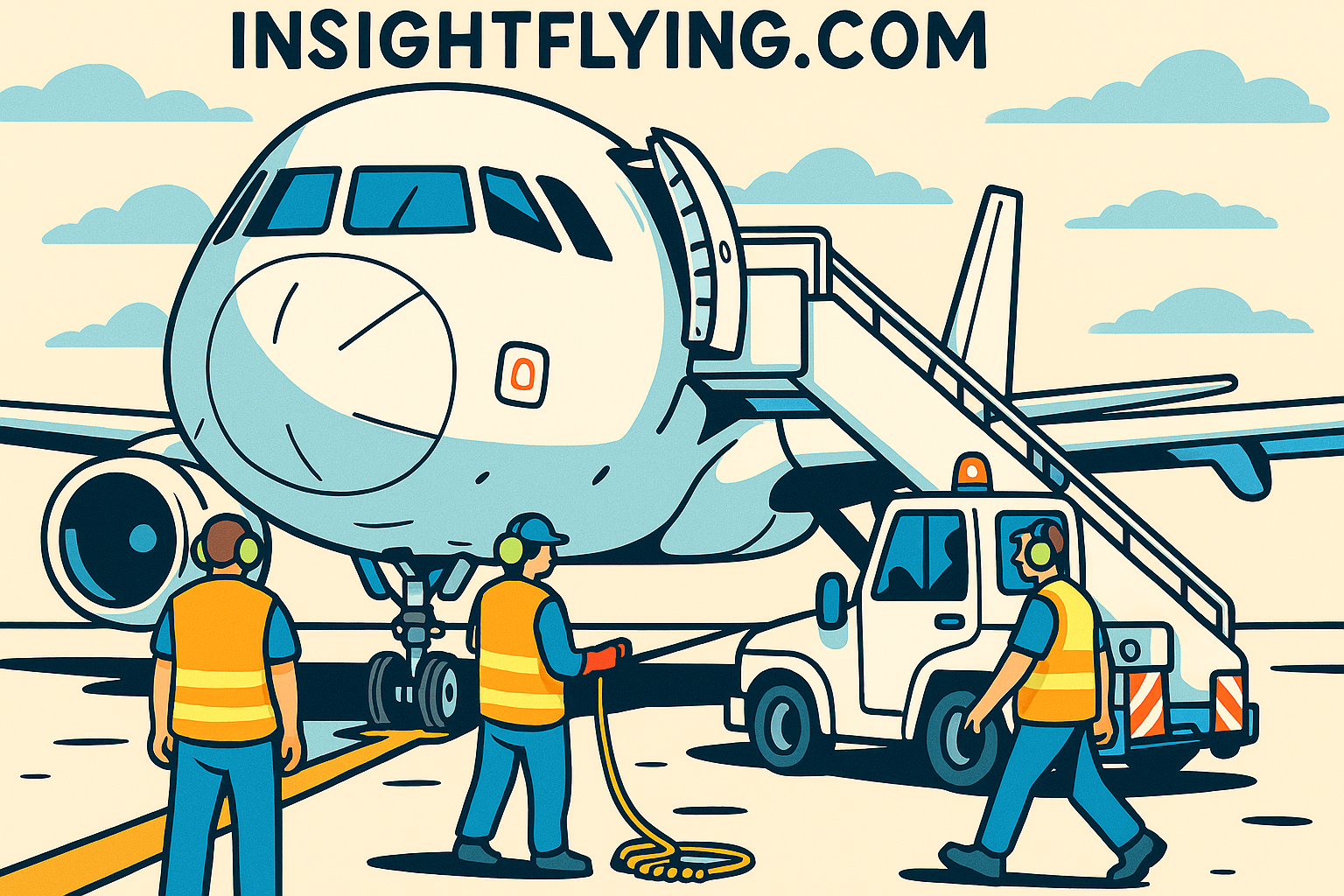Ground Operations Explained – Part 2
When passengers board an aircraft and the cabin doors close, the flight is only at the very beginning of its journey. Before the airplane can taxi to the runway, one important step usually comes first: pushback.
🔹 What is Pushback?
Pushback is the procedure of moving an aircraft backwards, away from its parking bay, using a specialized ground vehicle called a pushback tug or tow tractor. Since most commercial aircraft do not have the capability to reverse using their own engines safely, pushback is the standard method used in airports worldwide.
Pushback ensures:
- Safe clearance from terminal buildings and other aircraft
- Controlled positioning for taxiing
- Reduced risk of jet blast damaging nearby equipment or personnel
🔹 The Role of Ground Crew
Pushback is a highly coordinated operation between pilots and ground staff. Key ground personnel include:
- Marshaler – guides the aircraft while approaching or leaving the stand
- Pushback Operator (tug driver) – controls the tug vehicle
- Wing Walkers – positioned near the wingtips to ensure obstacle clearance
- Headset Operator – maintains direct communication with pilots during pushback
Each member plays a role in keeping the operation precise and safe.
🔹 Communication and Clearance
Before pushback can begin, the flight crew must obtain pushback clearance from Ground Control. The clearance ensures that taxiways behind the aircraft are clear and that no conflicts will occur with other aircraft or vehicles.
Typical communication flow:
- Pilot → Ground Control: Request pushback
- Ground Control → Pilot: Grant clearance with specific taxiway instructions
- Pilot → Ground Crew: Confirm ready for pushback via headset
- Pushback begins once both ATC and ground crew give the go-ahead
🔹 Apron Operations and Safety Zones
The apron (also called the ramp) is the area where aircraft are parked, loaded, refueled, and boarded. It is one of the busiest parts of any airport. To maintain safety, aprons are marked with lines, zones, and lighting:
- Stand lead-in lines: Guide pilots to stop at the correct position
- Safety zones: Areas around aircraft engines and propellers where no one should enter during operation
- Equipment parking zones: Designated spaces for ground vehicles to prevent congestion
🔹 Why Pushback Matters
While pushback may look simple, it is a critical phase of ground operations. Mistakes can cause:
- Collisions with other aircraft or vehicles
- Damage to engines, wings, or ground equipment
- Delays that ripple through airline schedules
Well-trained ground crews and clear communication with air traffic control are the keys to making pushback operations smooth and safe.
✈️ Pushback และการปฏิบัติการบน Apron
Ground Operations Explained – ตอนที่ 2
หลังจากผู้โดยสารขึ้นเครื่องและปิดประตูแล้ว การเดินทางของเที่ยวบินยังไม่เริ่มต้นจริง ๆ เครื่องบินยังต้องผ่านขั้นตอนสำคัญก่อนที่จะเคลื่อนที่ไปยังรันเวย์ นั่นคือ Pushback
🔹 Pushback คืออะไร
Pushback คือขั้นตอนการถอยหลังเครื่องบินออกจากหลุมจอด โดยใช้รถลากพิเศษที่เรียกว่า Pushback Tug หรือ Tow Tractor เนื่องจากเครื่องบินพาณิชย์ส่วนใหญ่ไม่สามารถถอยหลังด้วยกำลังเครื่องยนต์เองได้อย่างปลอดภัย Pushback จึงเป็นวิธีมาตรฐานที่ใช้กันทั่วโลก
ประโยชน์ของ Pushback ได้แก่:
- ทำให้เครื่องบินออกจากหลุมจอดได้อย่างปลอดภัย
- ควบคุมทิศทางการเคลื่อนที่ได้แม่นยำ
- ลดความเสี่ยงจากแรงดันไอพ่น (Jet Blast) ที่อาจสร้างความเสียหายต่ออุปกรณ์หรือบุคลากรใกล้เคียง
🔹 บทบาทของเจ้าหน้าที่ภาคพื้น
Pushback เป็นงานที่ต้องอาศัยความร่วมมืออย่างใกล้ชิดระหว่างนักบินและเจ้าหน้าที่ภาคพื้น โดยมีบุคลากรหลักดังนี้:
- Marshaler – ผู้โบกสัญญาณนำเครื่องบินเข้าและออกจากจุดจอด
- Pushback Operator (คนขับ Tug) – ควบคุมรถลากที่ทำการถอยเครื่องบิน
- Wing Walkers – เดินตรวจสอบบริเวณปลายปีกเพื่อป้องกันการชนสิ่งกีดขวาง
- Headset Operator – สื่อสารโดยตรงกับนักบินผ่านชุดหูฟัง
ทุกตำแหน่งมีหน้าที่เฉพาะ และช่วยให้การปฏิบัติการดำเนินไปอย่างปลอดภัย
🔹 การขออนุญาตและการสื่อสาร
ก่อนเริ่ม Pushback นักบินต้องขอ Pushback Clearance จาก Ground Control เพื่อยืนยันว่าทางขับ (Taxiway) ที่อยู่ด้านหลังเครื่องปลอดภัย และไม่มีการชนหรือทับเส้นทางกับเครื่องบินลำอื่น
ขั้นตอนสื่อสารทั่วไป:
- นักบิน → Ground Control: ขออนุญาต Pushback
- Ground Control → นักบิน: ให้การอนุญาต พร้อมเส้นทางการ Taxi
- นักบิน → Ground Crew: ยืนยันความพร้อมผ่าน Headset
- เริ่ม Pushback เมื่อได้รับสัญญาณยืนยันทั้งจาก ATC และเจ้าหน้าที่ภาคพื้น
🔹 ความปลอดภัยบน Apron
Apron หรือพื้นที่ลานจอด เป็นเขตที่เครื่องบินจอด โหลดสัมภาระ เติมน้ำมัน และขึ้นลงผู้โดยสาร ถือเป็นพื้นที่คึกคักที่สุดของสนามบิน การจัดระเบียบความปลอดภัยจึงสำคัญมาก เช่น:
- Stand Lead-in Lines: เส้นบังคับให้นักบินหยุดที่ตำแหน่งที่ถูกต้อง
- Safety Zones: เขตปลอดภัยรอบเครื่องยนต์และใบพัด ที่บุคลากรห้ามเข้าใกล้ขณะทำงาน
- Equipment Parking Zones: จุดจอดของรถภาคพื้นและอุปกรณ์ เพื่อลดความแออัด
🔹 ทำไม Pushback ถึงสำคัญ
แม้จะดูเป็นเพียงขั้นตอนเล็ก ๆ แต่ Pushback คือจุดเริ่มต้นของความปลอดภัยทั้งเที่ยวบิน หากเกิดความผิดพลาดอาจทำให้:
- เครื่องบินชนกับสิ่งกีดขวางหรืออากาศยานลำอื่น
- เกิดความเสียหายกับเครื่องยนต์หรือปีก
- เกิดความล่าช้าในการบิน ซึ่งส่งผลต่อแผนการบินทั้งเครือข่าย
ดังนั้นการฝึกฝนเจ้าหน้าที่ภาคพื้นให้มีมาตรฐานสูง และการสื่อสารที่ชัดเจนกับหอบังคับการบิน คือหัวใจสำคัญของความปลอดภัย
หนังสือการบิน ทางลัดสู่ความเข้าใจที่นำไปใช้งานจริง

|
|

|
|

|
|

|
|

|
|
ขายดีที่สุด

|
|
